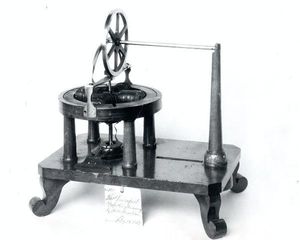Davenport's Motor
Michael Faraday and others constructed experimental devices that converted electricity into mechanical motion, but they were so small and weak that they were not useful for practical purposes. Other inventors saw the electric motor as a potential rival to the steam engine, which was the dominant form of power for industrial purposes. One of these inventors was Thomas Davenport (1802-1851), of Brandon, Vermont. In 1834 he built a powerful motor that converted electric power to rotating mechanical power (most industrial machines needed a source of rotating power), and patented the idea in 1837. As he built larger and larger models, they became powerful enough to run lathes, drills, and even a printing press. His largest motor had a diameter of about one meter (three feet). Davenport hoped that a very large model of his motor would be powerful enough to operate a railroad train, but the limitations of batteries made such a plan impossible at the time.
